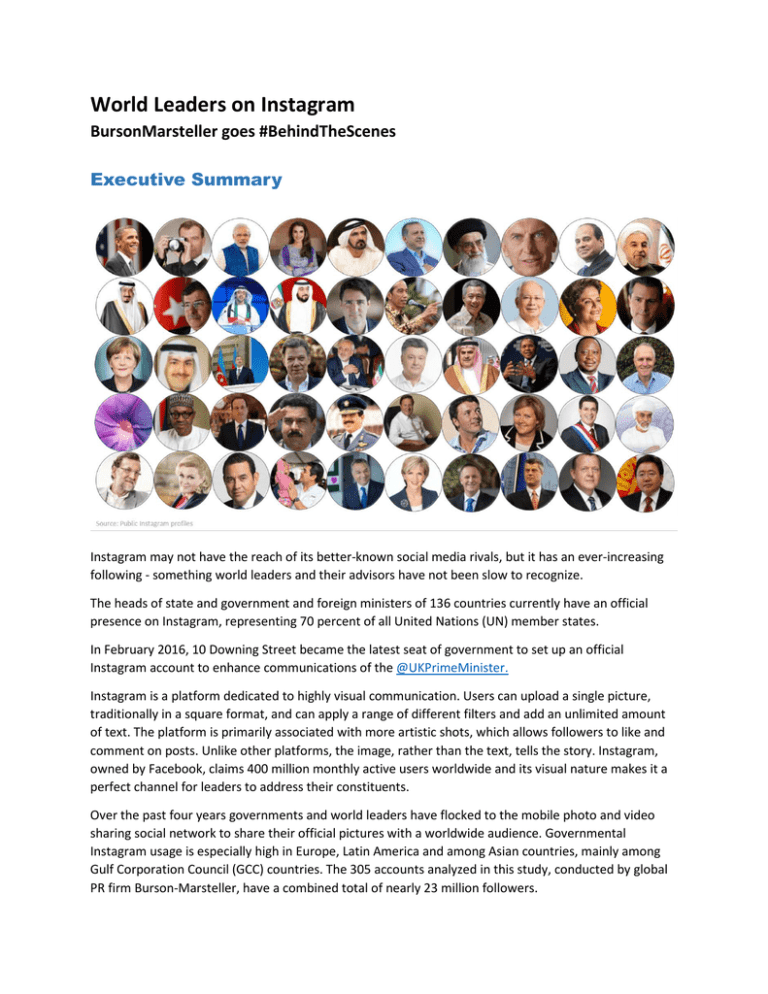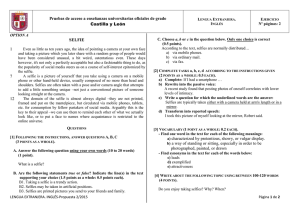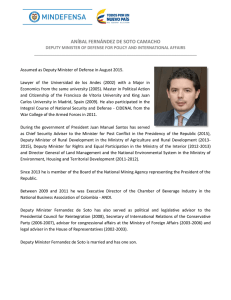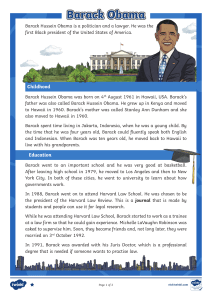World Leaders on Instagram - Burson
Anuncio

World Leaders on Instagram BursonMarsteller goes #BehindTheScenes Executive Summary Instagram may not have the reach of its better-known social media rivals, but it has an ever-increasing following - something world leaders and their advisors have not been slow to recognize. The heads of state and government and foreign ministers of 136 countries currently have an official presence on Instagram, representing 70 percent of all United Nations (UN) member states. In February 2016, 10 Downing Street became the latest seat of government to set up an official Instagram account to enhance communications of the @UKPrimeMinister. Instagram is a platform dedicated to highly visual communication. Users can upload a single picture, traditionally in a square format, and can apply a range of different filters and add an unlimited amount of text. The platform is primarily associated with more artistic shots, which allows followers to like and comment on posts. Unlike other platforms, the image, rather than the text, tells the story. Instagram, owned by Facebook, claims 400 million monthly active users worldwide and its visual nature makes it a perfect channel for leaders to address their constituents. Over the past four years governments and world leaders have flocked to the mobile photo and video sharing social network to share their official pictures with a worldwide audience. Governmental Instagram usage is especially high in Europe, Latin America and among Asian countries, mainly among Gulf Corporation Council (GCC) countries. The 305 accounts analyzed in this study, conducted by global PR firm Burson-Marsteller, have a combined total of nearly 23 million followers. Who is the Most Followed? Barack Obama’s campaign account (@BarackObama), set up on January 4, 2012 for the election campaign of the same year, is the most followed Instagram account of any world leader, with more than 6 million followers, far ahead of Russian Prime Minister Dmitry Medvedev with more than 2 million followers. India’s Prime Minister Narendra Modi is in third place, despite having posted only 37 pictures, just ahead of the White House with 1.7 million followers each. Queen Rania of Jordan and HH Sheikh Mohammed bin Rashid Al Maktoum, the Emir of Dubai, each have 1.4 million followers. Turkey's President Recep Tayyip Erdoğan, Iran's Supreme Leader Ali Khamenei, Argentinian President Mauricio Macri and Egyptian President Abdelfattah el-Sisi complete the Top 10 list with more than half a million followers each. Barack Obama is also the most effective leader on Instagram, with more than 56,000 interactions (comments and likes) for every post on the site. He is closely followed by the Indian Prime Minister. Russia’s Dmitry Medvedev; HH Sheikh Mohammed bin Rashid Al Maktoum, the Emir of Dubai; and Sheikh Abdullah bin Zayed Al Nahyan, the Foreign Minister of the United Arab Emirates, all receive more than 25,000 interactions per post. 2 The most liked post of all world leaders is the Thank You picture of Barack Obama after being reelected on November 7, 2012; Barack Obama also posted the most commented picture, garnering almost 200,000 comments on the image showing the U.S. President getting a flu shot with the caption: “Tell us how your life is #BetterWithObamacare”. Barack Obama was notably the first world leader to set up an Instagram account, on January 4, 2012, followed by Argentina's President Mauricio Macri and Danilo Medina, the President of the Dominican Republic. However, a number of world leaders have given up posting on the network after the initial enthusiasm wore off: A third of the accounts surveyed have either been dormant for more than a year or have never been active. All world leaders combined have posted a total of 76,387 photos and videos and the vast majority of posts are pictures of large gatherings such as election rallies, conferences, government meetings and bilateral meetings with their foreign counterparts. The Information Department of the government of Brunei is the most active government account, with more than four posts per day on average. The Foreign Ministry and the Foreign Minister of Kuwait are also prolific. The presidential administration of Venezuela often packs nine shots into one post, using the Instagram Layout app. These governments have discovered Instagram as a formidable channel to post pictures of their leaders’ daily activities and their Instagram accounts have become the central repository for all official government pictures. However, few of the pictures are particularly riveting and many are posting staged handshake pictures, which get few likes and which would possibly be better used on Snapchat where they disappear after 24 hours. What to Post? As the saying goes, a picture is worth a thousand words, but Instagram is not the most obvious social network to make policy statements or hard-hitting announcements. A few governments have posted screenshots of their most salient tweets on Instagram in the hope of increasing their impact. 3 Others have posted a picture of their leader with an excerpt from a speech or a screenshot of a presidential decree. The White House generally posts pictures of presidential letters of pardon and Buckingham Palace posts selected royal letters, be it to congratulate the Davis Cup team or the latest British astronaut in space. A number of politicians have promoted hashtags to support specific campaigns, such as the campaign to #BringBackOurGirls, (those who have been abducted by Boko Haram), or calling on followers that it is #TimeToAct to end sexual violence against women, initiated by the UK Foreign Office. It is particularly difficult to break sad news and express condolences on Instagram, such as after the Paris attacks in November 2015 which drew international condemnation. Several world leaders such as German Chancellor Angela Merkel, Spanish Prime Minister Mariano Rajoy, Secretary of State John Kerry and many others posted pictures signing the book of condolences in their respective French embassies. The British Monarchy posted a picture of the Union Jack being lowered on Buckingham Palace while others posted pictures of government buildings lit up in the French Tricolor. After the downing of Air Malaysia flight MH17 over eastern Ukraine on July 17, 2014, Malaysia’s Prime Minister Najib Razak posted a black and white picture of his press conference and a black and white picture of the plane with the hashtag #PrayForMH17. Many politicians take to Instagram during election campaigns and use the network generally to show a lighter side of their personality. Once elected, their accounts become less interesting with less popular engagement. The Instagram accounts of Chile’s President Michelle Bachelet, Polish President Andrez Duda, Italian Prime Minister Matteo Renzi, and Portuguese Prime Minister António Costa have all been dormant since their election and the picture of their election is their last post. The account of the Dutch royal household (@Koninklijkhuis) went into abeyance shortly after King Willem-Alexander acceded to the throne in April 2013. 4 Accounts Worth Following A handful of accounts stand out for posting unusual, behind-thescenes pictures. These accounts are often run by the official photographer or a dedicated social media team. While some photographers will slavishly follow their leader, posting every single picture of their meetings, others have an artistic license to post unusual pictures, capturing private moments of our leaders. Probably the best account to follow for personal pictures is that of the @WhiteHouse, run by Pete Souza, the chief official White House photographer, who also has a popular private channel on the network. Souza and his team have captured private moments of President Barack Obama and First Lady Michelle Obama which are then posted on different social media channels, including Instagram. In late 2015, the team even invited a group of 20 Instagrammers to the White House for a #WHInstaMeet letting them “roam through the White House taking pictures”. The U.S. administration also organized the #BigBlockOfCheeseDay, inviting Instagram followers to put questions to senior administration officials after the presidential State of the Union address. If you ever wanted to know what it means to take pictures behind the scenes, have a look at the posts from the State Department (@StateDept). While Secretary John Kerry never takes his own pictures, his official photographers capture unusual pictures from his meetings and trips which the social media team in Washington edits and posts on the official profile. The official photographer of German Chancellor Angela Merkel is trying to emulate the U.S. administration’s approach and has shared fascinating pictures from unusual angles during her official visits on the account of the @Bundeskanzlerin. Austrian Foreign Minister Sebastian Kurz has a small team of social media editors identified as #InstaLisa and #InstaStefan who follow ‘Sebastian’ on his official trips abroad and post #BehindTheScenes pictures on the @TeamKurz account. And finally @The_British_Monarchy has been sharing unusual pictures of the royal household, including the preparations and the menus of State Banquets, traditionally in French. The account also makes its followers salivate with some of the 20,000 slices of cake served at the Queen’s annual garden party. One of the most unusual shots is of a horse’s hoof being polished in black for the state visit of the Mexican President. Buckingham Palace also posts pictures of award recipients, but almost no private shots from the Queen herself. Occasionally the account will repost photos of Prince George from the 5 @KensingtonRoyal Instagram account. The Russian government has set up a dedicated picture feed for all official Instagram pictures at @Photogovernment. Do they manage their own account? Fifteen world leaders manage their Instagram accounts themselves and usually take their own pictures and selfies, namely Presidents Joko Widodo (@Jokowi), @MauricioMacri, @PenaNieto, Prime Ministers @damedvedev, @Erna_Solberg, @LeeHsienLoong, @Najib_Razak, @TRoivas, and Foreign Ministers @DidierReynders, @EdgarsRinkevics, @GebranBassil, @kasnms, @Khalid_bin_Ahmad, @KristianJensenum and @NasserJudeh. Probably the most entertaining world leader on Instagram is Singapore’s Prime Minister Lee Hsien Loong (@LeeHsienLoong). The 63-year-old politician has posted more than 40 ‘wefies’ or group selfies. Prime Minister Lee even posted a selfie from his hospital bed after surgery to remove his prostate gland. He sometimes captures other world leaders in his selfies and even started to present his snapshots as official presents to his guests. His regular “#GuessWhere” photographic riddles are one of the key reasons to follow his account. Russian Prime Minister Dmitry Medvedev (@damedvedev) is an amateur photographer and occasionally takes pictures out of airplanes or helicopters on his trips around the country. His picture before landing on the island of Kunashir in Russia’s Far East provoked the ire of the Japanese government, which is claiming ownership over the disputed island. Medvedev also made a strong political statement when posting a picture of apples on an apple tree, claiming that “Our apples are no worse than foreign!” in reference to the import restrictions on western produce in retaliation to the economic sanctions against Russia. Bahrain’s Foreign Minister, Khalid bin Ahmed Al Khalifa, clearly enjoys life judging from his Instagram posts. Be it playing golf, sampling Cuban cigars or sharing holiday snapshots from Havana, Portofino, Lake Como, Montreux or the Bahamas, his Instagram feed @Khalid_bin_Ahmad is a mix of official pictures, selfies with friends and colleagues and very personal posts. On his Instagram feed you can discover pictures of the most exquisite dinners as well as a collection of close-ups of his prayer beads. 6 First, Let’s Take a Selfie Most world leaders have embraced the selfie culture of their fans, happily agreeing to be featured in selfies, the digital equivalent of an autograph. A group of admirers will generally cuddle up close to their favorite leader to take a selfie. Especially during election campaigns, the Instagram accounts come alive with pictures of politicians surrounded by a crowd of admirers wanting to capture a selfie. Selfies seem to become a challenge for the security of some world leaders, as illustrated by some of the French President’s images now containing blurred images of his body guards in the background. Quite a few world leaders have joined the selfie craze and are happy to capture their audiences at political rallies and meetings. However, instead of sharing the selfies on their own Instagram feed, the social media teams will share the picture of the leader taking the selfie to illustrate his or her popularity. To take a selfie you often need a long arm. A handful of government leaders have taken selfies to a new level: the Prime Ministers of Malaysia, Spain and Turkey have all been pictured using selfie sticks to capture their audience in their group selfie or “groufies.” Najib Razak, the Prime Minister of Malaysia, has taken a series of selfies with his international counterparts from Barack Obama to the Prime Minister of Singapore. Norwegian Prime Minister Erna Solberg, who manages her Instagram account herself, often posts group selfies, including one with other world leaders as does the Foreign Minister of Kuwait who captured Monaco’s Prince Albert on the sidelines of the UN General Assembly. Whatever you think about selfies, they are far more personal and entertaining than traditional, handshake pictures. Some world leaders have also shared solo selfies. Russian Prime Minister Dmitry Medvedev regularly gratifies his followers with a selfie. His mirror-selfie in an elevator to thank his 400,000 followers has become his most popular post, liked more than 200,000 times. Bahrain’s Foreign Minister took a selfie on top of the Burj Khalifa, the highest building in the world, to express his amazement at the development of Dubai. 7 In general, world leaders have little time to take pictures of themselves or to post them to their Instagram channel. Latvian Foreign Minister Edgars Rinkēvičs exclusively posts wildlife and landscape pictures and sometimes pictures from an airplane, as does his Jordanian counterpart Nasser Judeh. Instagram allows world leaders to show a very personal side. Estonian Prime Minister Taavi Roivas happily shares personal family selfies with his wife and daughter among pictures of his official meetings. Lebanese Foreign Minister Gebran Bassil also mixes official pictures with his personal holiday pictures and selfies with his children, but rarely adds descriptions to his snapshots. That task is often left to their official photographer who will build a visual profile of the leader. Instagram is the ideal channel to show a leader in a new light – either playing football, basketball, volleyball or rugby, enjoying skiing in winter or jogging, running a marathon or a triathlon. Our leaders seem to be very sporty and health conscious judging from their Instagram feeds. Who is the Most Creative? After having reviewed tens of thousands of pictures posted on Instagram we would like to highlight several rather creative ones. - The Estonian Prime Minister shared a close-up of a bowl of oranges with the caption: “We’ve arrived in Georgia” in reference to the country’s role as a citrus fruit exporter during Soviet 8 - - - - times. Taavi Rõivas also shared a snapshot of his leg and that of an unidentified visitor both wearing colorful socks. Argentina’s President Mauricio Macri shared a picture of his legs under the presidential table as well as a picture of his closet with “two shirts and a tie (just in case)”. The White House shared a similar picture of Barack Obama’s wardrobe, explaining that “the President's suiting up for the big speech” ahead of the State of the Union address in 2015. Hungary’s Viktor Orban posted a picture of his tie on a chair, explaining that it was “Saturday 07:45” after all. The European Commission’s social media manager shared a close-up picture of changing shoes at the annual meeting of the World Economic Forum in Davos. Singapore’s Prime Minister Lee used a similar picture of his shoes on the floor mat of Facebook’s HQ to post a cheeky “#GuessWhere”-post. The presidential administration of Ecuador shared a picture of President Rafael Correa making the sign of the heart to wish a happy holidays. Justin Trudeau paid homage to Canadian actor Leonard Nimoy, better known as Spock from Star Trek, by imitating Spock’s signature salute. The Instagram feed of Canada’s newly elected Prime Minister is worth following for its candor. A fifth of all the photos posted by world leaders have been ‘embellished’ with Instagram filters. Valencia, Amaro, Lo-fi, Rise, X-Pro II, and Ludwig are the most popular filters used by world leaders. Only four percent of all the Instagram publications by world leaders are videos, however each video receives on average 4,300 likes, double as many as a simple picture. The number of video posts is bound to increase as government communications become more professionalized. The most liked post from the White House is a video of Michelle and Barack Obama’s Halloween greetings. The Elysée Palace in Paris shares mainly professionally produced 15-second videos of François Hollande’s activities on Instagram, a shorter version of which often will be posted on the Elysée’s Vine channel. The @EUCouncil has also increased its video production on Instagram, editing arrivals of European leaders or summing up foreign visits by European Council President Donald Tusk. Dutch Prime Minister Mark Rutte (@minpres) publishes regular 15 second Instagram vlogs. The Irish government @MerrionStreet started its foray into Instagram with a series of video statements from ministers about the 2014 budget. Among the more entertaining clips is the video of Kazakh President Nursultan Nazarbayev ice fishing. 9 Finally, several leaders have shown their creativity and Instagram mastery by building collages with a series of Instagram posts. Brazilian President Dilma Rousseff and Spanish Prime Minister Mariano Rajoy both posted a series of pictures to form a collage during their respective election campaigns. The European Commission posted three pictures in a row to capture the EU team around a long table at the COP 21 in Paris. The managers of the account also created a collage with the Berlaymont building, the Commission’s headquarters, as well as a collage with four pictures of Jyrki Katainen, the EU Commission Vice President which look great on mobile devices, where most users access Instagram. 10 About This Study World Leaders on Instagram is Burson-Marsteller's latest research into how world leaders, governments and international organizations communicate via social media. The research builds on BursonMarsteller's highly acclaimed annual Twiplomacy study. Initially focused solely on Twitter, the 2016 study is being expanded to other social media platforms including Facebook, Instagram, YouTube, Google+ and more niche digital diplomacy platforms such as Snapchat and Vine. Burson-Marsteller has identified a total of 305 Instagram, 35 of which have been verified by Instagram and carry a blue verification mark. The 270 remaining pages are not verified, but we believe that they can be considered as official pages. Interestingly 64 pages are dormant for more than a year and 33 are inactive and have never posted a single photo. 15 accounts are private and we could not get any data. We did not include accounts set up by private individuals, such as a fan page for Pope Francis (@Pontifex_es) which, despite its 100,000 followers, is clearly not official, nor the page of the Russian President @President_Vladimir_Putin which has more than 25,000 followers but is not his official page. We have also discarded the @Kremlin_Russian page, which has half a million followers but posts political cartoons and unflattering pictures of Western leaders which are hopefully not endorsed by the Kremlin. The page of the King of Morocco (@Roi.du.Maroc.Mohammed.6) is not official, either, despite sharing amazingly candid personal pictures of King Mohamed VI. Lastly, we have not included inactive pages without a profile picture as it was virtually impossible to determine their authenticity. Data was collected on February 2, 2016, using Burson-Marsteller’s proprietary Burson Tools to analyze the 305 world leaders’ Instagram accounts. More than 30 variables were considered, including: followers, following, post count, post likes and post comments, et al. The full data set can be downloaded here. Thank you to Matthias Lüfkens for his ongoing strategic guidance on Twiplomacy and the World Leaders on Social Media series. February 2016 11




